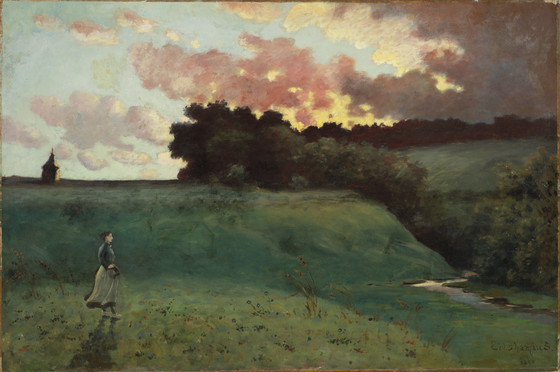Eilshemius’s early paintings were almost all landscapes. These were unlike the personal style with which he later became identified but were typical of the period....
Eilshemius’s early paintings were almost all landscapes. These were unlike the personal style with which he later became identified but were typical of the period. As did many late nineteenth-century artists, Eilshemius fell under the influence of GEORGE INNESS and Jean-Baptiste-Camille Corot (1796-1875) and produced paintings that could be considered to be in the Barbizon manner. Stormy Landscape reflects Inness’s concern for weather conditions, specifically his love for approaching storms, as well as his colorful, poetic palette.
Eilshemius painted the clouds in shades of pink, lavender, and gold to form a brilliant foil for the somber greens and blues of the foreground and distant trees. Eilshemius also constructed his composition as INNESS so often did by composing it around an expansive, open field in a settled area of the countryside. While Eilshemius captured the dramatic poetry of INNESS, he avoided the hazy atmosphere of Inness’s late paintings.
Small figures in peasant dress often appear in paintings of the Barbizon school. Here the woman seems to be wearing simple rustic clothes and wood shoes. The relatively large scale of the figure is more in keeping with those in the paintings of Corot than of Inness, except in the latter’s work of the mid-1880s. While the painting reads as a landscape rather than as a figure composition set outdoors, the figure is an essential element of the painting, forming a compositional counterpoint to the stream on the right and row of trees in the background. Moreover, the woman contributes to the unsettling mood by her disproportionate scale and mysterious activity.
More...



